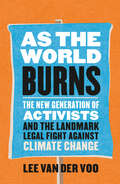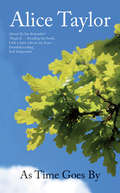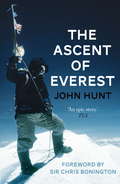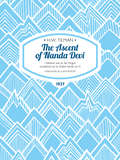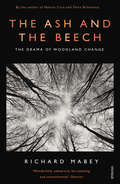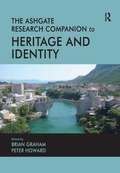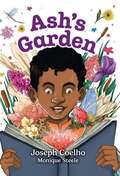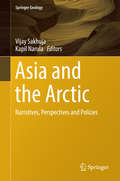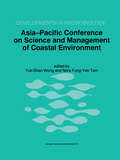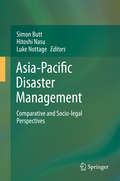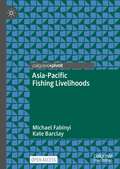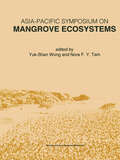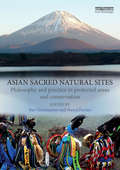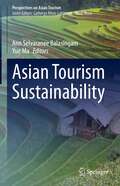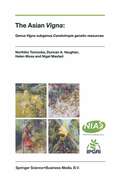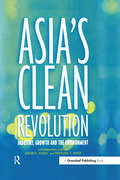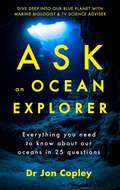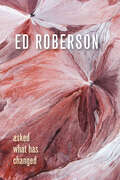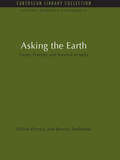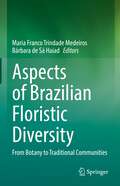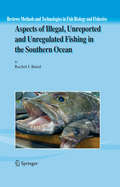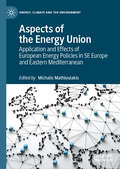- Table View
- List View
As the World Burns: The New Generation of Activists and the Landmark Legal Fight Against Climate Change
by Lee van der VooAward-winning investigative journalist Lee van der Voo reports on Juliana v. the United States. Combining unparalleled access to the plaintiffs and reporting on the natural disasters that form an urgent backdrop to the story, van der Voo shares a timely and important story about the environment, the law, and the new generation of activists.
As Time Goes By
by Alice TaylorAlice Taylor brings the reader with her on her 80th birthday year. Alice had a big birthday on the horizon, the village was about to celebrate many milestones, and she had just received the gift of a book focusing her on the art of living well. So she decided to write about her year as it unfolded, to keep a journal of the big events, and record the twists and turns normal life brings to all of us in just one year. But 2018 turned out to be far from normal, with storms, snow blizzards, blistering sun, severe drought and water shortages. She describes the challenges of all these dramatic weather changes. Alice began the year wondering how she would feel about reaching eighty. She was pleasantly surprised to discover that it was just another milestone on a journey that is still varied and interesting. Here she writes about these feelings, and the many pleasant and challenging events of her eightieth year.
Ascent of Everest: Special Sales (Teach Yourself Ser.)
by John HuntThis is the story of how, on 29 May, 1953, two men, both endowed with outstanding stamina and skill, reached the top of Everest and came back unscathed to rejoin their comrades. 'Yet this will not be the whole story, for the ascent of Everest was not the work of one day, nor even of those few anxious, unforgettable weeks in which we prepared and climbed this summer. It is, in fact, a tale of sustained and tenacious endeavour by many, over a long period of time... We of the 1953 Everest Expedition are proud to share the glory with our predecessors.'Sir John Hunt
The Ascent of Nanda Devi: I believe we so far forgot ourselves as to shake hands on it (H.W. Tilman: The Collected Edition #2)
by H.W. TilmanIn 1934, after fifty years of trying, mountaineers finally gained access to the Nanda Devi Sanctuary in the Garhwal Himalaya.Two years later an expedition led by H.W. Tilman reached the summit of Nanda Devi. At over 25,000 feet, it was the highest mountain to be climbed until 1950.The Ascent of Nanda Devi, Tilman’s account of the climb, has been widely hailed as a classic. Keenly observed, well informed and at times hilariously funny, it is as close to a ‘conventional’ mountaineering account as Tilman could manage. Beginning with the history of the mountain (‘there was none’) and the expedition’s arrival in India, Tilman recounts the build-up and approach to the climb.Writing in his characteristic dry style, he tells how Sherpas are hired, provisions are gathered (including ‘a mouth-blistering sauce containing 100 per cent chillies’) and the climbers head into the hills, towards Nanda Devi. Superbly parodied in The Ascent of Rum Doodle by W.E. Bowman, The Ascent of Nanda Devi was among the earliest accounts of a climbing expedition to be published. Much imitated but rarely matched, it remains one of the best.
The Ash and The Beech: The Drama of Woodland Change
by Richard MabeyFrom ash die-back to the Great Storm of 1987 to Dutch elm disease, our much-loved woodlands seem to be under constant threat from a procession of natural challenges. Just when we need trees most, to help combat global warming and to provide places of retreat for us and our wildlife, they seem at greatest peril. But these dangers force us to reconsider the narrative we construct about trees and the roles we press on them.In this now classic book, Richard Mabey looks at how, for more than a thousand years, we have appropriated and humanised trees, turning them into arboreal pets, status symbols, expressions of fashionable beauty - anything rather than allow them lives of their own. And in the poetic and provocative style he has made his signature, Mabey argues that respecting trees' independence and ancient powers of survival may be the wisest response to their current crises. Originally published with the title Beechcombings, this updated edition includes a new foreword and afterword by the author.
The Ashgate Research Companion To Heritage And Identity (PDF)
by Brian Graham Peter HowardHeritage represents the meanings and representations conveyed in the present day upon artifacts, landscapes, mythologies, memories and traditions from the past. It is a key element in the shaping of identities, particularly in the context of increasingly multicultural societies. This Research Companion brings together an international team of authors to discuss the concepts, ideas and practices that inform the entwining of heritage and identity. They have assembled a wide geographical range of examples and interpret them through a number of disciplinary lenses that include geography, history, museum and heritage studies, archaeology, art history, history, anthropology and media studies. This outstanding companion offers scholars and graduate students a thoroughly up-to-date guide to current thinking and a comprehensive reference to this growing field.
Asia and the Arctic: Narratives, Perspectives and Policies (Springer Geology)
by Vijay Sakhuja Kapil NarulaThis book presents narratives, perspectives and policies on the Arctic and brings to fore the strategies of five Asian countries - China, India, Japan, Republic of Korea and Singapore who were granted the status of Permanent Observers in the Arctic Council in 2013. The book also captures Arctic countries’ reactions to Asian approaches, and their expectations from these countries. The melting of the polar sea-ice induced by climate change has placed the Arctic region in the forefront of global scientific, economic, strategic and academic interest. The discourse involves a number of issues such as claims of the littoral countries to the continental shelves of the region, the management and exploitation of its living and non-living resources, the rights and interests of indigenous communities, and the prospects of new ice-free shipping routes. The contemporary discourse also suggests that the Arctic region presents challenges and offers opportunities for the international community. These issues have given rise to new geopolitical, geoeconomic, and geostrategic dynamics amongst the Arctic littorals, and led to the growing interest of non-Arctic states in the affairs of the Arctic. It is evident that the Asian countries have a variety of interests in the Arctic, and the grant of Permanent Observer status to these countries is an acknowledgement of their capabilities. These countries are keen to explore opportunities in the Arctic, and have begun to formulate appropriate long-term national strategies. The preliminary approach of the Asian Observer countries has rightly been to graduate from ‘involvement’ to ‘engagement’ in the Arctic, which seems to have generated significant interest amongst analysts. This book helps to understand the approaches of various Arctic and non-Arctic stakeholders, in light of the evolving dynamics in the region.
Asia-Pacific Conference on Science and Management of Coastal Environment: Proceedings of the International Conference held in Hong Kong, 25–28 June 1996 (Developments in Hydrobiology #123)
by Yuk-Shan Yuk-Shan Wong Nora Fung-Yee TamHuman beings have a long historical relationship with the coast. Initially it provided food and security, later forming important locations for industrial and commercial development. Now the emphasis has shifted towards leisure and conservation, although the former functions remain crucial. However, it is only very recently that people have started viewing the coast as a common and valuable resource that requires rational utilisation and scientific management in order to sustain its attractiveness. Of course, enlightened management comes only through understanding of the complicated coastal regions, which enables coastal managers to balance pressures from different sectors and to minimize risks. Scientific knowledge will continue to be the most important basis for resolving the conflicts between coastal users and interest groups such as developers and ecologists. Coastal management has also shifted from traditional restorative or remedial actions towards planned avoidance of other conflicts. Despite rapid advancement in coastal sciences over recent decades, most of the major coastal issues have remained outstanding in the agenda. Control of shoreline erosion and protecting sea level rise continue to be crucial problems facing coastal scientists. Destructive coastal storms still cause tremendous damage, particularly in low altitudes. Wetland and estuary reclamation have led to the loss of the most valuable estuary wetlands which are required to sustain biological productivity and biodiversity. This volume includes papers on marine and coastal pollution, eutrophication, aquaculture, conservation and utilization, coastal wetlands, and coastal zone management.
Asia-Pacific Disaster Management: Comparative and Socio-legal Perspectives
by Simon Butt Hitoshi Nasu Luke NottageThe book outlines the regulatory environment for disaster prevention and management in broad social, economic and political context. The first half of the book focuses mainly on Japan, especially the ‘3-11’ events: the earthquake and tsunami that devastated the Tohoku area on 11 March 2011 and the Fukushima Daiichi nuclear power plant radiation leaks. The second half focuses on the USA (the only other Asia-Pacific country to have experienced a serious nuclear emergency), Indonesia, China, New Zealand, Australia and international law. One question explored is whether socio-legal norms play different roles in preventing and managing responses to natural disasters compared to ‘man-made’ disasters. Another is how ‘disaster law’ interacts with society across very diverse societies in the disaster-prone Asia-Pacific region. The book also addresses the increasingly important roles played by international law and regional regimes for cross-border cooperation in disaster prevention and relief, including the functions played by military forces.Erudite, pragmatic, and charged with detailed, substantive knowledge of an astonishing range of contexts and research fields, this timely collection of important essays on the law and society of disaster management stands as an exemplary international academic response to the disasters of 11 March 2011. (Annelise Riles)
Asia-Pacific Fishing Livelihoods
by Michael Fabinyi Kate BarclayThis open access book explores fishing livelihoods in the context of the wider contexts in which they are embedded. Drawing on case studies from across the Asia-Pacific region, the book highlights how fishing livelihoods are shaped by globalisation, social relationships and governance. The book concludes by showing how better understanding these relationships can contribute to governance for healthier ecosystems and social wellbeing.This is an open access book.This is an open access book.
Asia-Pacific Symposium on Mangrove Ecosystems: Proceedings of the International Conference held at The Hong Kong University of Science & Technology, September 1–3, 1993 (Developments in Hydrobiology #106)
by Yuk-Shan Yuk-Shan Wong Nora F. Y. TamMangrove ecosystems are typical formations found in coastal deposits of mud and silt throughout the tropics and some distance into the subtropical latitudes. The total wordwide mangrove area, which is estimated at about 170,000 km2 with some sixty species of trees and shrubs exclusive to the habitat, dominates approximately 75% of the world's coastline between latitudes 25°N and 25°S. Such unique intertidal ecosystems support genetically diverse communities of terrestrial and aquatic organisms that are of direct or indirect socioeconomic values. Mangrove forests play important roles as coastal stabilization and protection against winds and storms; producers of nutrients, forest resources and animal species of economic importance. Recently, the issues on the conservation, proper utilization and management of mangrove forests have been widely discussed. Unfortunately, overexploitation and destruction of mangroves seriously threatens the sustainability of such a unique ecosystem. This volume includes papers on three main areas: recent advances in mangrove ecology; application and utilization of mangrove resources; and conservation and management of the ecosystems.
Asian Sacred Natural Sites: Philosophy and practice in protected areas and conservation
by Bas Verschuuren Naoya FurutaNature conservation planning tends to be driven by models based on Western norms and science, but these may not represent the cultural, philosophical and religious contexts of much of Asia. This book provides a new perspective on the topic of sacred natural sites and cultural heritage by linking Asian cultures, religions and worldviews with contemporary conservation practices and approaches. The chapters focus on the modern significance of sacred natural sites in Asian protected areas with reference, where appropriate, to an Asian philosophy of protected areas. Drawn from over 20 different countries, the book covers examples of sacred natural sites from all of IUCN’s protected area categories and governance types. The authors demonstrate the challenges faced to maintain culture and support spiritual and religious governance and management structures in the face of strong modernisation across Asia. The book shows how sacred natural sites contribute to defining new, more sustainable and more equitable forms of protected areas and conservation that reflect the worldviews and beliefs of their respective cultures and religions. The book contributes to a paradigm-shift in conservation and protected areas as it advocates for greater recognition of culture and spirituality through the adoption of biocultural conservation approaches.
Asian Sacred Natural Sites: Philosophy and practice in protected areas and conservation
by Bas Verschuuren Naoya FurutaNature conservation planning tends to be driven by models based on Western norms and science, but these may not represent the cultural, philosophical and religious contexts of much of Asia. This book provides a new perspective on the topic of sacred natural sites and cultural heritage by linking Asian cultures, religions and worldviews with contemporary conservation practices and approaches. The chapters focus on the modern significance of sacred natural sites in Asian protected areas with reference, where appropriate, to an Asian philosophy of protected areas. Drawn from over 20 different countries, the book covers examples of sacred natural sites from all of IUCN’s protected area categories and governance types. The authors demonstrate the challenges faced to maintain culture and support spiritual and religious governance and management structures in the face of strong modernisation across Asia. The book shows how sacred natural sites contribute to defining new, more sustainable and more equitable forms of protected areas and conservation that reflect the worldviews and beliefs of their respective cultures and religions. The book contributes to a paradigm-shift in conservation and protected areas as it advocates for greater recognition of culture and spirituality through the adoption of biocultural conservation approaches.
Asian Tourism Sustainability (Perspectives on Asian Tourism)
by Ann Selvaranee Balasingam Yue MaThis book brings together a collection of chapters that investigate sustainable tourism development in different Asian contexts; from stakeholders’ perspectives, existing issues in the market, as well as the impacts of COVID-19 on tourism. It highlights the importance of tourism sustainability in Asia. Specifically, this book examines these themes by examples related to Asian tourism such as; social-cultural impact of sustainable growth, environmental constraints and policies, community engagement, moral limits of the market, stakeholders’ participation in tourism development, the hindered interaction between foreign tourists and local community, impact of the pandemic and proposed ways forward. This edited volume substantiates this by using evidence of quantitative, qualitative and mixed methods approaches aligned with empirical data to show sustainable efforts and impacts. This book is of interest to researchers and practitioners as it offers timely understandings of sustainable tourism from multiple perspectives within the Asian context.
The Asian Vigna: Genus Vigna subgenus Ceratotropis genetic resources
by Norihiko Tomooka D. Vaughan Helen Moss Nigel MaxtedThe Asian beans and grams, the species of Vigna (subgenus Ceratotropis), include several legumes that are an essential component in the diets of a large proportion of Asia's population, and interest in these legumes is growing as ethnic cuisine spreads worldwide. However, this important group of legumes is little known compared to the closely related Phaseolus beans and soybean. That deficiency is addressed for the first time in this fully illustrated comprehensive conservation, genetics, taxonomic, and agricultural monograph on the genetic resources of the Asian Vigna. The book deals with the phylogeny of the group from the perspectives of morphological and molecular analyses, ex situ and in situ conservation, eco-geographical analyses, and research. In addition, morphological descriptions, keys, and eco-geographic details of each species in the group are provided. This genetic resources handbook and guide to the Asian Vigna will be a valuable reference for agriculturists, conservationists, taxonomists, other scientists, and students interested in the legumes and plant genetic resources.
Asia's Clean Revolution: Industry, Growth and the Environment
by David Angel Michal RockThe world's environmental future will be determined in significant part by what happens in the rapidly industrialising and urban economies of Asia. The sheer scale of urban population and industrial growth in Asia - from Indonesia to China - and the energy and materials intensive character of the development process constitutes a dark shadow over the region's, and indeed the world's, environment. And yet this challenge is also an opportunity. Precisely because so much of the urban-industrial investment within developing Asia has yet to take place, the opportunity exists to shape a different development future - one that is far less energy, materials and waste intensive.Asia's Clean Revolution examines the prospects for and pathways to such a new trajectory. The book lays out a path-breaking vision of how developing economies might go beyond environmental regulation and put in place an array of policies and institutions that could integrate environmental, industrial and technological goals. These findings provide important input for negotiators considering climate change on a global scale.The book approaches the challenge of growth and environment in Asia in a novel way, by identifying six major transformational dynamics under way in the world today, and assessing whether these can be harnessed to the goal of improved environmental performance of industry.With a set of specially commissioned chapters from the leading authorities in North America and Asia, this ground-breaking book is the first to present concrete policy solutions to the looming crisis driven by large-scale urban-industrial growth in developing Asia.
Asia's Clean Revolution: Industry, Growth and the Environment
by David Angel Michal RockThe world's environmental future will be determined in significant part by what happens in the rapidly industrialising and urban economies of Asia. The sheer scale of urban population and industrial growth in Asia - from Indonesia to China - and the energy and materials intensive character of the development process constitutes a dark shadow over the region's, and indeed the world's, environment. And yet this challenge is also an opportunity. Precisely because so much of the urban-industrial investment within developing Asia has yet to take place, the opportunity exists to shape a different development future - one that is far less energy, materials and waste intensive.Asia's Clean Revolution examines the prospects for and pathways to such a new trajectory. The book lays out a path-breaking vision of how developing economies might go beyond environmental regulation and put in place an array of policies and institutions that could integrate environmental, industrial and technological goals. These findings provide important input for negotiators considering climate change on a global scale.The book approaches the challenge of growth and environment in Asia in a novel way, by identifying six major transformational dynamics under way in the world today, and assessing whether these can be harnessed to the goal of improved environmental performance of industry.With a set of specially commissioned chapters from the leading authorities in North America and Asia, this ground-breaking book is the first to present concrete policy solutions to the looming crisis driven by large-scale urban-industrial growth in developing Asia.
Ask an Ocean Explorer
by Dr Jonathan Copley'Deftly conjures the wonders of a bathynaut's world' - Nature'An engaging book sprinkled with mind-blowing facts about the deep ocean' - Daily ExpressIt is often said that we know more about space than we do our own oceans, but is that really the case? Or do we in fact know a great deal more about the oceans than many people realise.The wellbeing of our oceans and the life contained within and around them has never been more important. But to truly understand the vital role they play, we need to first understand how the oceans work, how we explore them and learn about the mysteries they hold, and what our effect is on them.Between these pages is everything you need to know about our oceans, explained in 25 questions. Combining untold history of ocean exploration and personal account of what it's like to be a 'bathynaut' diving in a mini-submarine, Ask an Ocean Explorer brings to light weird and wonderful deep-sea creatures and how the oceans and their future is connected to our everyday lives.
Asked What Has Changed (Wesleyan Poetry Series)
by Ed RobersonAward-winning poet Ed Roberson confronts the realities of an era in which the fate of humanity and the very survival of our planet are uncertain. Departing from the traditional nature poem, Roberson's work reclaims a much older tradition, drawing into poetry's orbit what the physical and human sciences reveal about the state of a changing world. These poems test how far the lyric can go as an answer to our crisis, even calling into question poetic form itself. Reflections on the natural world and moments of personal interiority are interwoven with images of urbanscapes, environmental crises, and political instabilities. These poems speak life and truth to modernity in all its complexity. Throughout, Roberson takes up the ancient spiritual concern—the ephemerality of life—and gives us a new language to process the feeling of living in a century on the brink.Morello's Venice startled to hear the doctor saythis would be the last time he would see it,a person used to keeping things alivetalking terminus — even more startled when he returnedto hear him say it wasn't therethere were terrible rainsbookings cancelled. when late he arrived,everything was gone.his wife had a cold. they bundled together in blankets.he refilled my prescription torestore my soul.
Asking the Earth: Farms, Forestry and Survival in India (Natural Resource Management Set)
by Winin Pereira Jeremy SeabrookThe need to produce food without the destructive chemical horrors of much modern farming, for an intelligent use of dwindling natural resources and for humane forms of production is universal, the practice is limited. This book is an account of one, large, instance of success in practice. Twenty-five years ago, Winin Pereira, a nuclear physicist abandoned academia to start a co-operative farm at Alonde in a tribal area north of Bombay. The group experienced, and finally discarded, all the false hopes and promises of Western originated forms of development: ploughs that ploughed too deep, irrigation systems that lowered water tables, fertilizers and pesticides which managed the earth and became so expensive that poorer farmers were dispossessed. Instead they learnt from the adivasai, or tribal people, who have nurtured or been nurtured by foresets for millennia, ways of applying popular knowledge to contemporary problems. This book is a combination of Pereira's record of achievement of sustainable livelihoods and an account of the farm and its effect on the India around it by a leading British journalist. Originally published in 1991
Asking the Earth: Farms, Forestry and Survival in India (Natural Resource Management Set)
by Winin Pereira Jeremy SeabrookThe need to produce food without the destructive chemical horrors of much modern farming, for an intelligent use of dwindling natural resources and for humane forms of production is universal, the practice is limited. This book is an account of one, large, instance of success in practice. Twenty-five years ago, Winin Pereira, a nuclear physicist abandoned academia to start a co-operative farm at Alonde in a tribal area north of Bombay. The group experienced, and finally discarded, all the false hopes and promises of Western originated forms of development: ploughs that ploughed too deep, irrigation systems that lowered water tables, fertilizers and pesticides which managed the earth and became so expensive that poorer farmers were dispossessed. Instead they learnt from the adivasai, or tribal people, who have nurtured or been nurtured by foresets for millennia, ways of applying popular knowledge to contemporary problems. This book is a combination of Pereira's record of achievement of sustainable livelihoods and an account of the farm and its effect on the India around it by a leading British journalist. Originally published in 1991
Aspects of Brazilian Floristic Diversity: From Botany to Traditional Communities
by Maria Franco Trindade Medeiros Bárbara de Sá HaiadAspects of Brazilian Floristic Diversity: From Botany to Traditional Communities offers a unique approach in floristic diversity of the Neotropical region, specifically encompassing the Brazilian flora. This volume combines both theoretical and applied aspects of scientific making knowledge in different perspectives of Botanical Science. In this volume, botanical specialists discuss the many different approaches of taxonomic, reproductive, ecological and ethnobotanical aspects of Brazilian floristic diversity, thereby enlightening the global interest in Neotropical species, in particular those from the Brazilian territory. The book addresses relevant questions from many points of view, including anatomy, reproduction, palinology, conservation and ethnobotany, creating an in-depth perception of the flora in its complexity constitution.The book provides a comprehensive outlook on Botany Sciences, considering the history and traditional knowledge of plants, and relating it to contemporary problems and concerns of flora conservation today. With this current perspective, this book reaches a vast audience from the research lines of Botany, and encompasses a broader and interdisciplinary understanding of Aspects of Brazilian Floristic Diversity.
Aspects of Illegal, Unreported and Unregulated Fishing in the Southern Ocean (Reviews: Methods and Technologies in Fish Biology and Fisheries #5)
by Rachel BairdIllegal, Unreported and Unregulated (IUU) fishing threatens the viability of high seas living resources. This book details the efforts of the Convention for the Conservation of Antarctic Marine Living Resources Commission and the Australian government to adopt complementary measures to deter IUU fishing in the Southern Ocean. It describes how these various measures have proven effective in deterring IUU operators.
Aspects of the Energy Union: Application and Effects of European Energy Policies in SE Europe and Eastern Mediterranean (Energy, Climate and the Environment)
by Michalis MathioulakisThis book provides a comprehensive exploration of some of the most critical issues regarding the EU’s Energy Union policy. Applied European energy policies face a number of challenges ranging from the geopolitics of energy and energy regulation, to climate change, advancing renewable and gas technologies, and consumer empowerment structures. This book takes a multi-dimensional look into some of these vital issues regarding the European energy sector with a special focus on the effects the Energy Union policy has in two sensitive regional systems, Southeastern Europe and the Eastern Mediterranean.Energy, being by definition a multi-disciplinary field, presents a challenge for readers of any specific disciplinary background that need to grasp an overall understanding of the various aspects of this exciting sector. This book’s objective is to offer the opportunity for readers to get a quality, hands-on overview of the Energy Union by the professionals and academics that interact with it on a daily basis.
